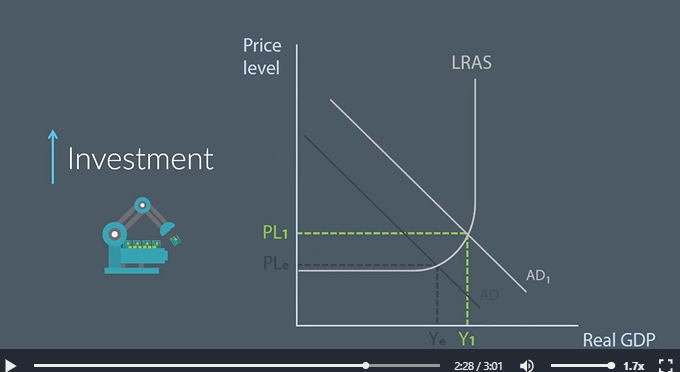4.2 poverty and inequality
1/12
There's no tags or description
Looks like no tags are added yet.
Name | Mastery | Learn | Test | Matching | Spaced |
|---|
No study sessions yet.
13 Terms
Absolute poverty
Absolute poverty is being unable to afford basic necessities such as food, clean water and shelter.
World bank measured absolute poverty by looking at the number of people living on less than $3 a day in 2025, measured at purchasing power parity.
2025 estimated over 700 million people live in poverty.
Purchasing power parity tells us how much of one currency is needed to purchase a basket of goods compared to another currency.
Relative poverty.
Relative poverty is defined as earning less than a particular percentage of a country’s average income. In the UK, people living on less than 60% of the average income are in relative poverty.
Changes in poverty
1) infrastructure
2) education & training
3) aid
infrastructure:
1970 New Community Movement - gave raw materials like bags of cement to villages across all of rural couth korea for free. gave each village 5 step program to follow, show them how to divide the work up amongst the villages and how to build water access, roads and villages. better roads allowed the workers to transport their crops more easily and bridges opened up more efficient roots. farmers could sell and grow more crops, making them more productive and earn higher incomes, absolute poverty decreased.
electric grids in China have allowed Chinese companies to get more power and expand their factories, creating new jobs,raising income and lifting chinese workers out of poverty.
A lack of access to electricity for 8 hours a day has very significant negative impact on infrastructure. It leads to considerable reduction in productivity meaning businesses make less profit. This will in turn lead to increased unemployment and reduced incomes. As a result, people will remain in poverty and it is possible that the number of people living below the poverty line will increase.
The new roads will allow workers to become more mobile which will lead to an increase in employment. At the same time, production costs will decrease as it becomes cheaper for businesses to operate. This will make them more productive. As a result, profits and incomes will increase and poverty will decrease. . New Community Movement in 1970s provided raw materials for South Korean villages and helped them to build their roads and bridges systems.- lead to higher incomes and reduction in absolute poverty.
Education and training
A fall in the standard of education may lead to a decrease in skills which will lower productivity and therefore reduce incomes. This can significantly increase absolute poverty.
aid
Aid can reduce poverty. If aid is spent on healthcare or education it can make workers more productive which should increase their incomes and demand higher incomes and reduce poverty. e.g. Pakistan £374m pounds on healthcare and education. However, aid may not decrease poverty is it ends up going to corrupt politicians.2011 Somalia receive $1.3B in Aid but 70% went to corrupt politicians.
PMT causes of changes in poverty
Absolute poverty tends to fall as GDP increases.
relative poverty been growing for a number of reasons:
-growing inequality in wages growth. wages of the richest are now 170 times than the average worker.
-has been a growth in underemployment, zero-hour contracts, part-time jobs and temporary jobs, lower wages for workers.
- a decline of trade unions has left many workers unable to bargain for higher wages,
-long term and structural unemployment had risen.
-state benefits have fallen whilst taxes have increased.
-de-industrialisation, fewer factories has increased the number of service sector jobs which tends to be lower paid.
Inequality
Income inequality
Income is the flow of money received each year.
Income inequality occurs when the best paid workers take home more income than the rest of a country’s workers. For example, the average American CEO was paid around 192 times more than the average workers in 2024.
LORENZ CURVE
Lorenz curve takes a group of people and plots all of their incomes from the lowest earners to the highest earners.
We measure cumulative income, the income that accumulates as we go through our group of workers, adding up income from first to last.
Line of perfect equality and the Lorenz curve.
Perfect income income equality. Everyone is earning the same so it is a straight 45 degree line.
Income inequality produces a curve that starts of fairly flat ( the poorest workers earn a small amount of income) and then gets stepper as the richest workers earn higher amounts of income.
Lorenz curve- measures income inequality across countries.
entire population- cumulative % of population.
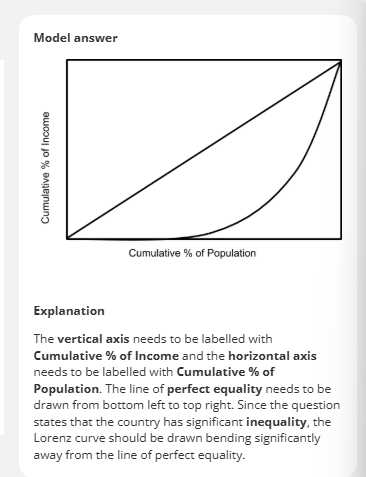
Using the Lorenz curve
Lorenz curve- measure income inequality across countries.
The closer a countries Lorenz curve is to the 45 line of perfect equality, the more equal its incomes are.
Use Lorenz curve to measure income inequality across countries.
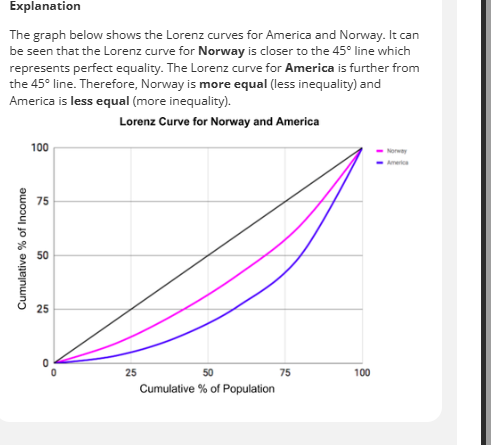
A diagram to show a Lorenz curve for a country does not have significant income inequality.
Low income equality curve will be closer to 45 degree line of perfect equality.

Inequality
The Gini Coefficient.
Gini coefficient+ A/(A+B)
As Gini coefficient increases, income inequality increases.
A Gini coefficient of 1 represents total income inequality which means that one person earns an entire country’s income.
A Gini coefficient for a perfectly equal economy is 0.
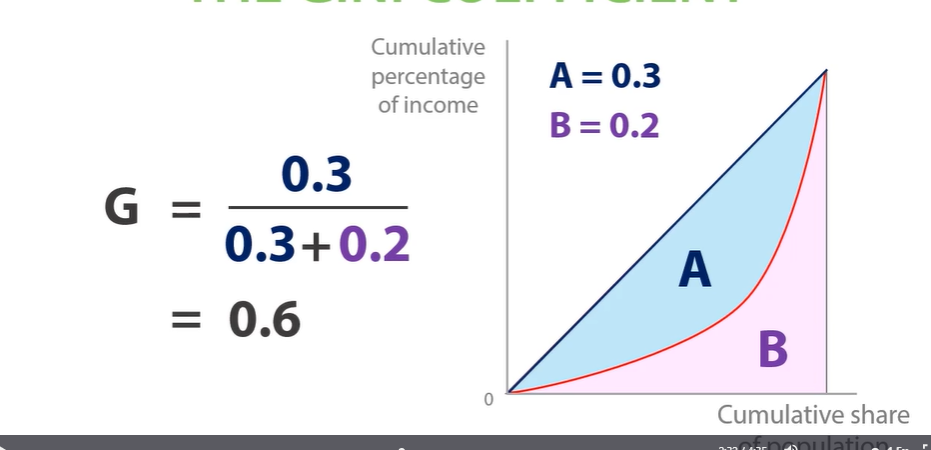
Inequality
Wealth inequality
Income inequality - is when the best paid workers take home far more income than the rest of a country’s workers. This can be measured with the Lorenz Curve and Gini Coefficient.
Wealth inequality- wealth is a stock of all assets. Wealth inequality is when wealth is shared unequally between a population. 8 men in the world own same wealth as poorer half of the world population combined.
income inequality and wealth inequality
Income inequality occurs when some people earn more than the rest of the population.
Wealth inequality occurs when assets are shared unequally between the population.
Changes in inequality
-Minimum wage rates
-social assortative mating
-social benefits and tax
- the r>g Hypothesis
-Inheritance
The introduction of a minimum wage will increase wage costs for a business. This will decrease their profits, which may mean that the manager will receive a lower income. Poorer workers will receive a higher wage as a result of the minimum wage. The poor get richer and the rich get poorer so there is a decrease in income inequality. - narrow
A decrease in the minimum wage will decrease wage costs for a business. This will increase their profits, which may mean that the manager will receive a higher salary. This will then decrease income equality. -wide inequality gap
Assortative mating
Assortative mating is when talented, successful and rich people get married to and have children with other talented, successful and rich people. Children have quality education and lifestyle, more successful and richer, income inequality increases.
Progressive tax
Progressive tax means that high earners pay a higher percentage of their income in tax and low earners pay a lower percentage of their income tax. The tax revenue is gained is used on Social benefits like job-seekers allowance and pensions decrease the gap between the rich and poorest people in society. This decreases income inequality.
The r>g hypothesis
Thomas Piketty argues that if r, the rate of return on wealth, is greater than g, the rate of income growth, then wealth will grow faster than incomes.
Rich people with assets get wealthier at a rate greater than workers with no assets. This means wealth inequality will increase.
Between 1950 -2012 wealth has received average rate of return r of 5.3% a year. Growth rate has only been around 3.8% a year. R greater than G.
2024 top 10% of American households held around 67% of countries wealth. Bottom 50% only held 2.4% of the countries wealth.
Inheritance
-Inheritance means that people receive lots of wealth, which can be used to generate even more wealth and more income. This will worsen wealth inequality and income inequality.
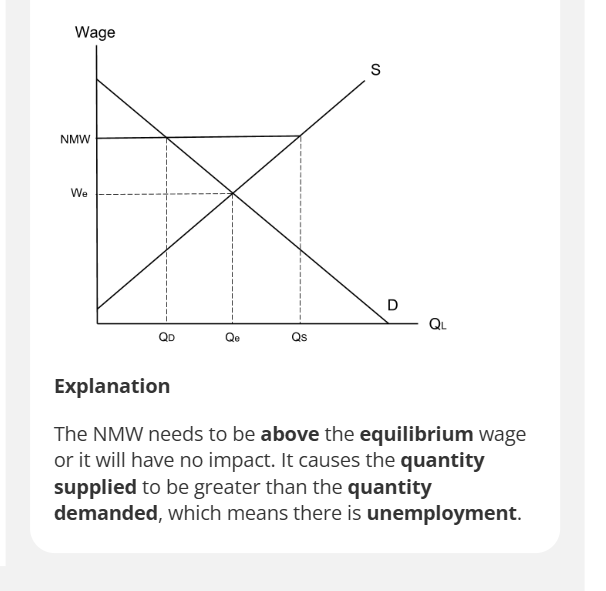
Capitalism, growth and inequality,
Capitalists and capitalism
Economic growth profits and inequality
Economic growth winners, losers and inequality
Capitalists are people who own and use any of the factors of production in the hope of making profit.
Capitalism- describing an economy with capitalists in it.
Command economies are not very capitalist because all factors of production are allocated by the government.
Mixed economies are partially capitalist because some factors of production are allocated by the government and others are allocated by the price mechanism.
Free market economies are very capitalist because all factors of production are allocated by the price mechanism.
Economists think capitalism is a great thing. Capitalists invest their money in the economy, which leads to an outward shift in aggregate demand. This creates positive multiplier effects which can lead to consumption in the economy and a further shift in AD.
Finally, the profit motive encourages businesses to improve the productivity and the quantity of the factors of production. This leads to an outward shift in LRAS and an increase in real GDP.
Capitalism can improve investment, consumption and productivity in an economy.
Economic growth disadvantages:
Income inequality is when the best paid workers take home more income than the rest of a country’s workers.
Capitalism can create income inequality because business owners can decide their own wages. They can decide to pay themselves higher wages. They can pay their workers very low wages. lead to income inequality.
Capitalists can invest their profits for more wealth whilst workers are left with only their wages.
r>g hypothesis explains how the ownership of capital leads to wealth inequality. Owners of capital will growth wealthier than regular workers. lead to wealth inequality.
r > g - owners of capital will grow richer than regular workers..
Economic growth creates winners and losers
Capitalism leads to inequality because it is a system that creates winners and losers.
Capitalism creates inequality because people like Jonny invest their money and make a big profit. However sometimes people invest their money and lose all of it. Therefore, capitalism is a system which creates winners and losers.
However, mixed economies can reduce the gap between the winners and losers of capitalism. State provide- healthcare, education and benefits to afford necessities. To fund this, the government will tax the richest through income tax and corporation tax so it reduces the gap between the winners and losers in society.
Capitalism is good
However, capitalism did create inequality but also led to the creation of jobs and an increase in living standards. Risk takers improve the whole economy by increasing the amount of investment which leads to an outward shift in aggregate demand. This will increase derived demand for labour, increasing employment. This will lead to greater output and increase living standards for everyone.
Capitalists do not think that inequality is a bad thing because it raises everyone’s living standards and inequality motivates people to take risks and growth the economy.
Capitalism, inequality limits growth
-Capitalists are motivated by profit so they will pay their workers lower wages and make them work long hours. Workers will not have any money to make their investments into the economy. Therefore, aggregate demand will not shift out and growth will be lower than it could be.
If capitalists save their wealth then there is a withdrawal from the circular flow of income. It will also mean there will be less consumption and investment in the economy and aggregate demand will not shift out as far as it could. Therefore, workers do not see the increase in the living standards capitalists argue they would get.
